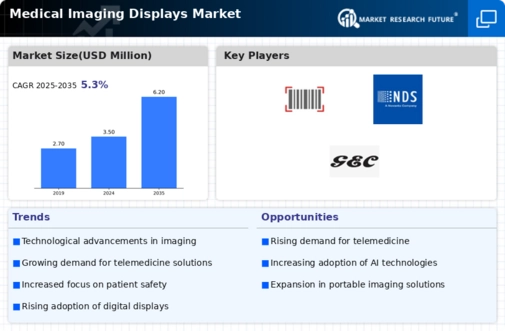Drivers
A few factors may drive the growth of thehealthcare imaging displays market. The rising demand for minimally invasive procedures, the growing popularity of large displays and their benefits, the increasing demand for diagnostic imaging procedures such as CT scans, MRIs, and other methods, as well as rapid technological advancements in the imaging sector, are some driving factors in themedical imaging displays market forecast.
Opportunities
The growing number of diagnostic and imaging facilities creates several opportunities, which will boost the medical display market throughout the forecast period. The market players are adopting various trends such as acquisitions and product launches, which are expected to boost the medical imaging displays market growth.
Restraints
Some factors that may inhibit the growth of medical imaging displays market value, such as the cost of the equipment. The rising demand for refurbished medical displays and the high cost of medical imaging displays are expected to hinder the market's growth.
Challenges
Some factors that may challenge the key medical imaging displays providers include the cost of the equipment. Moreover, there is a lack of healthcare infrastructure in many places. The population may also not be aware of the need for medical imaging equipment in healthcare. Hence, these factors challenge the key players of the global market.
Cumulative Growth Analysis
The medical imaging displays market is anticipated to grow substantially in the years to come. The healthcare imaging displays market value is expected to grow at a CAGR (Compound Annual Growth Rate) of about 5.4%. The market value was evaluated at approximately USD 1.98 billion by the end of the year 2018.
Value Chain Analysis
The increasing adoption of minimally invasive procedures, the growing popularity of large displays and their perks, the rising demand for diagnostic imaging procedures such as CT scans, MRIs, and other imaging procedures, and rapid technological advancements in the imaging sector are all driving the market. However, in the projection period, downward pricing pressure because of its commodity nature and a rise in the number of refurbished medical display adoptions are limiting the medical imaging displays market growth.
Medical Imaging Displays Market Segmentation
The globalmedical imaging displays marketis classified into many segments such as display technology, resolution, panel size, display color, and application. Listed below are the healthcare imaging displays market segments:
Medical Imaging Displays Technology Outlook
LED
AMOLED
PMOLED
CRT
TFT-LCD
PM-LCD
Medical Imaging Displays Resolution Outlook
2MP
1–4MP
1–8MP
Above 8MP
Medical Imaging Displays Panel Size Outlook
9 Inch
0-26.9 Inch
0-41.9 Inch
More than 42 Inch
Medical Imaging Displays Display Color Outlook
Monochrome display
Color display
Medical Imaging Displays Application Outlook
Diagnostic
Dentistry
General radiology
Surgical/interventional
Digital pathology
Mammography
Multi-modality
Others
Medical Imaging Displays Market Regional Analysis
The regional division of the medical imaging displays market analysis comprises North America, Europe, Asia Pacific, and the rest of the world. Because of technical advancements, rising healthcare expenditure, the availability of venture capital and government support, and the rising frequency of chronic illnesses in the area, the Americas are estimated to dominate the medical imaging displays market.
Due to the well-developed healthcare industry, significant government funding for research and development, and high healthcare spending in European nations, Europe is likely to occupy the second biggest market for medical imaging displays. The expansion of the market has also been aided by well-developed technology in the region.
Due to the increased usage of digital imaging systems, higher disposable income increased awareness programs and symposia, and growing venture capital investments, Asia-Pacific is expected to be the fastest expanding region in the medical imaging displays market. The Middle East and Africa region have the smallest market share for medical imaging displays. Also, due to increased government initiatives in the healthcare sector, the Middle East is likely to have the largest market share in the region.
Medical Imaging Displays Competitive Landscape
The medical imaging displays industry is dominated by a few companies that play a vital role in the market growth. These healthcare imaging displays companies are called key companies of the market. They contribute to the largest share of the market profit.
The companies account for the market profits by adopting various medical imaging displays market trends such as joint ventures, product launches, company expansions, and procurements.
Medical Imaging Displays Key Players
Below are the key companies that offer medical imaging displays in the global market:
Carestream Health
Koninklijke Philips N.V.
Siemens Healthcare Private Limited
Barco
NDS Surgical Imaging LLC
Ampronix
General Electric Company
Canon Medical Systems Corporation
Hitachi Medical Systems Europe Holding AG
PHC Holdings Corporation
The Contec Group
EIZO Corporation
Others
Recent Developments
Novarad introduced its OpenSight AR system, an imaging display based on Augmented Reality. It has also been authorized by the US Food and Drug Administration (FDA). Patients are exposed to less radiation as a result of this, and surgeons have superior planning skills.
Siemens Healthineers introduced their organ digital twin technology, which Artificial Intelligence powers. It helps stimulate the organ's physiology and assist clinicians in selecting the best potential therapy based on virtual testing on the digital twin.
The "ProFound AI" solution from iCAD is a digital breast tomosynthesis solution (DBT). It allows radiologists to see each tissue layer more clearly, allowing them to spot cancer up to 8% earlier on average. This can save radiologists up to 50% of the time they spend reading breast imaging.
Google's DeepMind can analyze 3D retinal OCT images and accurately identify 50 distinct ophthalmic diseases. It can identify signs of eye illness. It ranks patients according to their urgency and makes therapy recommendations. These skills have the potential to reduce the time between scan and therapy. This enables patients to receive life-saving treatments promptly.
Report Overview
Geographically
Europe
Asia-Pacific
North America
Middle East & Africa
Rest of the world
The ongoing advancements in imaging technologies and the increasing demand for high-resolution displays in healthcare settings appear to be driving a transformative shift in the global medical imaging displays market.
U.S. Food and Drug Administration (FDA)














Leave a Comment